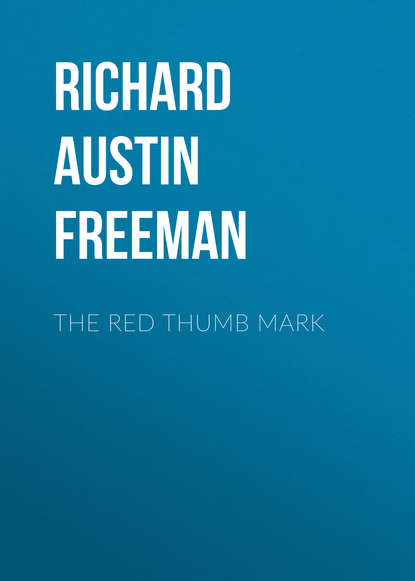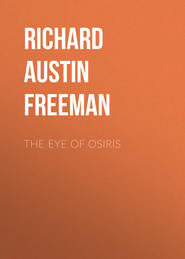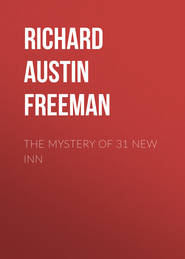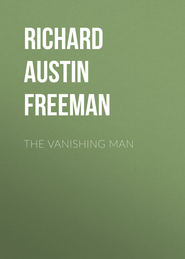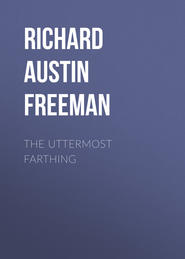По всем вопросам обращайтесь на: info@litportal.ru
(©) 2003-2024.
✖
The Red Thumb Mark
Настройки чтения
Размер шрифта
Высота строк
Поля
"Yes. In a few minutes more the jelly will begin to shrink and become more solid so that the blood will become separated into two parts, the solid and the liquid. The solid part will consist of a firm, tough jelly of a deep red colour, and the liquid part will consist of a pale yellow, clear, watery liquid."
"At the end, say, of two hours, what will be the condition of the drop of blood?"
"It will consist of a drop of clear, nearly colourless liquid, in the middle of which will be a small, tough, red clot."
"Supposing such a drop to be taken up on a piece of white paper, what would be its appearance?"
"The paper would be wetted by the colourless liquid, and the solid clot would probably adhere to the paper in a mass."
"Would the blood on the paper appear as a clear, red liquid?"
"Certainly not. The liquid would appear like water, and the clot would appear as a solid mass sticking to the paper."
"Does blood always behave in the way you have described?"
"Always, unless some artificial means are taken to prevent it from clotting."
"By what means can blood be prevented from clotting or solidifying?"
"There are two principal methods. One is to stir or whip the fresh blood rapidly with a bundle of fine twigs. When this is done, the fibrin—the part of the blood that causes solidification—adheres to the twigs, and the blood that remains, though it is unchanged in appearance, will remain liquid for an indefinite time. The other method is to dissolve a certain proportion of some alkaline salt in the fresh blood, after which it no longer has any tendency to solidify."
"You have heard the evidence of Inspector Sanderson and Sergeant Bates?"
"Yes."
"Inspector Sanderson has told us that he examined the safe at 10.31 a.m. and found two good-sized drops of blood on the bottom. Sergeant Bates has told us that he examined the safe two hours later, and that he took up one of the drops of blood on a piece of white paper. The blood was then quite liquid, and, on the paper, it looked like a clear, red liquid of the colour of blood. What should you consider the condition and nature of that blood to have been?"
"If it was really blood at all, I should say that it was either defibrinated blood—that is, blood from which the fibrin has been extracted by whipping—or that it had been treated with an alkaline salt."
"You are of opinion that the blood found in the safe could not have been ordinary blood shed from a cut or wound?"
"I am sure it could not have been."
"Now, Dr. Rowe, I am going to ask you a few questions on another subject. Have you given any attention to finger-prints made by bloody fingers?"
"Yes. I have recently made some experiments on the subject."
"Will you give us the results of those experiments?"
"My object was to ascertain whether fingers wet with fresh blood would yield distinct and characteristic prints. I made a great number of trials, and as a result found that it is extremely difficult to obtain a clear print when the finger is wetted with fresh blood. The usual result is a mere red blot showing no ridge pattern at all, owing to the blood filling the furrows between the ridges. But if the blood is allowed to dry almost completely on the finger, a very clear print is obtained."
"Is it possible to recognise a print that has been made by a nearly dry finger?"
"Yes; quite easily. The half-dried blood is nearly solid and adheres to the paper in a different way from the liquid, and it shows minute details, such as the mouths of the sweat glands, which are always obliterated by the liquid."
"Look carefully at this paper, which was found in the safe, and tell me what you see."
The witness took the paper and examined it attentively, first with the naked eye and then with a pocket-lens.
"I see," said he, "two blood-marks and a print, apparently of a thumb. Of the two marks, one is a blot, smeared slightly by a finger or thumb; the other is a smear only. Both were evidently produced with quite liquid blood. The thumb-print was also made with liquid blood."
"You are quite sure that the thumb-print was made with liquid blood?"
"Quite sure."
"Is there anything unusual about the thumb-print?"
"Yes. It is extraordinarily clear and distinct. I have made a great number of trials and have endeavoured to obtain the clearest prints possible with fresh blood; but none of my prints are nearly as distinct as this one."
Here the witness produced a number of sheets of paper, each of which was covered with the prints of bloody fingers, and compared them with the memorandum slip.
The papers were handed to the judge for his inspection, and Anstey sat down, when Sir Hector Trumpler rose, with a somewhat puzzled expression on his face, to cross-examine.
"You say that the blood found in the safe was defibrinated or artificially treated. What inference do you draw from that fact?"
"I infer that it was not dropped from a bleeding wound."
"Can you form any idea how such blood should have got into the safe?"
"None whatever."
"You say that the thumb-print is a remarkably distinct one. What conclusion do you draw from that?"
"I do not draw any conclusion. I cannot account for its distinctness at all."
The learned counsel sat down with rather a baffled air, and I observed a faint smile spread over the countenance of my colleague.
"Arabella Hornby."
A muffled whimpering from my neighbour on the left hand was accompanied by a wild rustling of silk. Glancing at Mrs. Hornby, I saw her stagger from the bench, shaking like a jelly, mopping her eyes with her handkerchief and grasping her open purse. She entered the witness-box, and, having gazed wildly round the court, began to search the multitudinous compartments of her purse.
"The evidence you shall give," sang out the usher—whereat Mrs. Hornby paused in her search and stared at him apprehensively—"to the court and jury sworn, between our Sovereign Lord the King and the prisoner at the bar shall be the truth,—"
"Certainly," said Mrs. Hornby stiffly, "I—"
"—the whole truth, and nothing but the truth; so help you God!"
He held out the Testament, which she took from him with a trembling hand and forthwith dropped with a resounding bang on to the floor of the witness-box, diving after it with such precipitancy that her bonnet jammed violently against the rail of the box.
She disappeared from view for a moment, and then rose from the depths with a purple face and her bonnet flattened and cocked over one ear like an artillery-man's forage cap.
"Kiss the Book, if you please," said the usher, suppressing a grin by an heroic effort, as Mrs. Hornby, encumbered by her purse, her handkerchief and the Testament, struggled to unfasten her bonnet-strings. She clawed frantically at her bonnet, and, having dusted the Testament with her handkerchief, kissed it tenderly and laid it on the rail of the box, whence it fell instantly on to the floor of the court.
"I am really very sorry!" exclaimed Mrs. Hornby, leaning over the rail to address the usher as he stooped to pick up the Book, and discharging on to his back a stream of coins, buttons and folded bills from her open purse; "you will think me very awkward, I'm afraid."
She mopped her face and replaced her bonnet rakishly on one side, as Anstey rose and passed a small red book across to her.
"Kindly look at that book, Mrs. Hornby."





